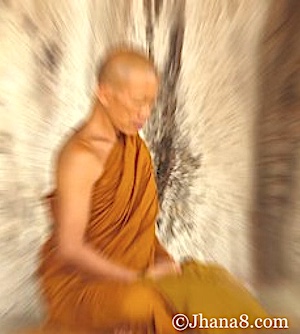[Page updated 21 August 2024]
Here is our Main Jhana Index >
Jhana is a controversial subject among people discussing it, for some obvious reasons you’ll appreciate as we get into the topic here. The major one being that most of the people discussing it have never experienced it firsthand, so they argue about what someone else said about it.
I’ve directly experienced the 8 levels of Jhana – the material and non-material Jhanas, so I speak from direct experience and I often contradict what someone has said about how to enter and move through the Jhana levels. Descriptions by others of the Jhanas, once inside, are usually very similar to my own.
We touch on some aspects of Jhana here that we don’t on this main Jhana page.
Theravada Buddhists have their interpretation of the Jhanas, based on what Buddha said about them.
There are some self-professed Buddhists who claim that ‘shallow Jhanas’ are really what is important, and they make a show of walking a person through the levels of Jhana in YouTube videos just by guiding them verbally through them.
Of course, to Buddhists who practice meditation their entire lives to reach Jhana, this appears to be a mockery of what they believe in.
Both sides have reasons for their beliefs. Personally, I side with the Buddhist monks and others across the world who believe the ‘hard Jhanas’ are the important ones. Whether or not the ‘soft’ or ‘shallow’ Jhanas exist at all, doesn’t concern me too much because my meditation practice resulted in the hard Jhanas without any knowledge of what they even were, or how I might reach them.
What Is Jhana (Dhyana, Dyanna)?
Jhana (Dyanna in Thai Theravada Buddhist language) are experiences in the mind usually brought on by meditation of some kind. Jhana are stages of relaxation in the mind that transition from one to the next by letting go of things present in the mind.
Once let go, a new stage with different features is revealed. Sort of like layers of an onion. Each subsequent (higher) Jhana is contained within the previous Jhana, and all Jhanas are contained entirely within the mind.
Thinking a lot about Jhana these days. It’s a big topic in the new meditation book I’m writing, so I’m thinking about it more than I ever have.
Jhanas are states of mind that begin when the body and mind are relaxed and the mind is highly focused on some object of meditation. Though Buddhism and other traditions teach that it is imperative to follow very specific rules to get into Jhana and move between the Jhanas, I’ve found this completely unnecessary.
I see Jhana as the fast track to big changes. Once getting Jhana pretty regularly, the revolution of the mind begins. As far as I can see, the changes, once made, are permanent.
I’ve struggled in the past to describe Jhana with words. Every person who has experienced them comes to the same conclusion – it is not easily done. A comprehensive description is never possible, and reading the description does not give the reader the exact experience, nor could it approach it.
Words are infinitely incapable of describing these states. It’s sort of like saying, describe the color orange – without using anything else that is orange to tell the person what it is like.
So, having exhausted myself trying to come up with words for the Jhanas that could transmit the experience, today I had a thought…
What if I Could Draw Jhana?
There is this driving force inside me that wants to share the experience with others, and yet, I haven’t found a way to do that yet. I’ve made some attempts at description using words here at this site and at others. I have to say that I’ve never come up with a great description of any of the Jhanas using words.
They defy description. Then today I wondered if drawing an image of Jhana could help people grasp it somehow.
Can Jhana be Described with a Drawing? A Photo? A Scribble?
I’ve been trying to come up with something for a couple of hours, and so far it’s elusive. If you look at the header image for this website, I made the “8” in Jhana8 to appear as if it is leaning, or falling. This was my attempt at showing that Jhana is similar to infinity, in that it is unknowable and completely indescribable.
Having exhausted myself thinking about a visual representation with an image or design I wondered, can it be described with music? Song? Dance? Sculpture? Numbers?
As far as I can see, a representation of Jhana cannot be created using any of these.
How can Jhana be a real experience and yet totally defy description of any sort? It is completely indescribable. I can only give hints at what it is… never anything resembling the big picture. I can explain tiny pieces of it, and not all that well, but at least it’s something.
It seems that most of the meditative experience is hard to describe with words. This is probably one factor that puts people off it. The milestones are ambiguous. The teachings – from Buddhists all over – often conflict.
There is even disagreement over what Jhana is and isn’t, the Buddhists are greatly concerned with the factors of Jhana and whether they are all present or not, and which ones should be present. Then, there are experiences that occur within the individual that are phenomenological, they don’t occur with other people, they are unique to that person.
I’ve had some of these strange experiences that nobody I know has ever had.
Features of the 4 (or 8) JHANAS
Some say there are four Jhana levels, and they are numbered 1-4. There are 4 more which have names instead of numbers.
The hard Jhanas have some common features, described by Ajahn Brahm here:
1. There is no possibility of thought except in the first jhana to a limited degree.
2. No decision-making process is available.
3. There is no perception of time.
4. Consciousness is non-dual, making comprehension inaccessible.
5. Yet one is very, very aware, but only of bliss that doesn’t move. (Vern disagrees with this for deep Jhanas).
6. The five senses are fully shut off, and only the sixth sense, mind, is in operation.
Why Attain Jhana?
Why should someone go through the effort to reach Jhana? The Buddhist perspective is that Buddha attained enlightenment (freedom from suffering, nibbana) after going through all the Jhana levels.
Living in the world is to be suffering, and Jhana practice is one path leading to freedom from all suffering.
Having gone through the Jhanas without becoming enlightened (that I know of), I can say that time in the Jhanas gives us a knowledge of our own mind and how it works.
It gives us tools we can use to control our emotions before they cause harm to ourselves or others. It gives us tools we can use to get a bigger perspective of life here on this planet as human beings surrounded by others, and how important social harmony is.
Another reason you might pursue the Jhanas is that the experiences awaiting you inside your own mind are nothing short of miraculous, for lack of a better term. As I meditated daily and watched small changes occur in my life, I hadn’t the slightest idea Jhanas were around the corner.
I hadn’t the slightest idea even what they were as I went through them one by one. Each level is something to behold, something to cause you endless wonder about later when you come out of your meditation session.
It’s certainly worth experiencing Jhana whether or not you have any of the reasons in the two previous paragraphs driving you. Do it because you can, and because it’s there for you… a gift perhaps, from whatever began this dance.
How To Reach Jhana?
Buddhists will insist that there is a very strict path that must be followed in order to enter into Jhana. This path is based on what Buddha said 2,500 years ago. This path is, in their minds, according to their religion, the only way that Jhana can be experienced.
This author disagrees, but that’s a topic for another page here at Jhana8.com. We’ll talk about how I came to Jhana without (much) Buddhism at all.
Let me clarify that the physical process and mental processes of my meditation could loosely be considered “Buddhist,” but I didn’t follow rules of Buddhism like the Eightfold Path or other rules. It’s entirely unnecessary to take the 100% Theravada Buddhist approach to finding Jhana.
Other paths exist. I only know of one. Because I found one that works, there may be others.
Further Reading About Jhana Levels
If you’re looking for a bible on the subject of Jhana – something where you can really dive deep into the subject and know all that you can possibly know intellectually about it before you experience it, the following will show you how.
There are two incredibly detailed Buddhist texts on Jhana that I have found to match 100% my own experiences in which Jhana was experienced but without following Buddhist rules. Meaning, I’ve found that the methods and rules these Buddhist monks teach must be followed, are in many cases completely optional and in some cases hurt your chances of ever experiencing Jhana.
- Overview of the Jhanas
- The Jhanas, by Ajahn Brahmavamso (link to website)
- A Critical Analysis of the Jhanas in Theravada Buddhist Meditation, by Henepola Gunaratana (download 252-page PDF)

